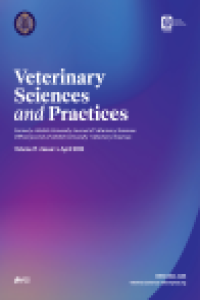Hemşin Koyunu Mandibula'sı Üzerinde Morfometrik Bir Çalışma
Bu çalışmanın amacı literatür de rastlanılmayan Hemşin koyunu mandibula’sı üzerinde morfometrik analizler yapmaktır.Çalışmada Doğu Karadeniz Bölgesinin Artvin ve Rize illerinde yaygın olarak et ve süt için yetiştirilen Hemşin koyunumandibula’sı farklılıklarının klasik morfometri yöntemleri kullanılarak belirlenmesi amaçlanmıştır. Bu amaçla 20 adet erişkinerkek Hemşin koyunu mandibula’sı kullanıldı. Mandibulalar kafadan ayrılıp deri ve kaba etleri temizlendikten sonra, hidrojenperoksit ile 25-30 dakika süreyle masere edildi. Mandibula’larda elektronik kumpas aracılığı ile 16 farklı noktalar arası uzunlukölçüldü. Daha sonra mandibula’lar Canon Digital Camera Zoom Lens 5X fotoğraf makinası ile fotoğraflandı. Fotoğraflarbilgisayar ortamına aktarıldıktan sonra elde edilen bütün ölçülerin ortalama, standart sapma ve korelasyon değerleri SPSS(18.0) versiyon programında belirlendi. Yapılan korelasyon analizi neticesinde uzunluk U1 ve U5 arasında, uzunluk U1 ve U6arasında, benzer şekilde uzunluk U2 ve U6 arasında ve uzunluk U5 ile U6 arasında pozitif güçlü bir korelasyon mevcut iken,uzunluk U9 ve U16 arasında negatif yönde güçlü bir korelasyonun olduğu görüldü. Erkek Hemşin koyun mandibulalarınınölçüleri literatürde belirtilen benzer çalışmalar ile karşılaştırıldığında, çalışmadaki değerlerin daha yüksek olduğu belirlendi.Literatürde rastlanılmayan bu çalışmanın daha sonrasında yapılacak Anatomik çalışmalara yardımcı olacağı kanaatine varıldı.
Anahtar Kelimeler:
Hemşin koyunu, Mandibula, Morfometri
Morphometric Analysis on the Mandible of Hemsin Sheep
The objective of this study is to conduct morphometric analyzes on male Hemsin sheep which is not found inliterature. The objective of this study is to specify the differences on the mandible of Hemsin sheep via conventionalmorphometry procedures, which is commonly bred in provinces of Artvin and Rize of Eastern Black Sea Region for meat andmilk consumption. For this purpose, twenty mandible of male adult Hemsin sheep have been used. After the mandibles leftthe head and the skin and muscle were cleaned, they were macerated with hydrogen peroxide for 25-30 minutes. Themandibles were measured from 16 different measurement points with the help of an electronic compass. Than mandibleswere photographed by a Canon Digital Camera Zoom Lens 5X. After the pictures had been computerized, the mean, standarddeviation and correlation values were identified on SPSS (18.0) software. According to the correlation analysis, there was astrong positive correlation between the values of the L1, L5 and L1, L6, similarly L2, L6 and L5, L9 in Hemsin sheep whilenegative correlation was strong and statistically important between L9 and L16 in Hemsin sheep. When the values of adultmale Hemşin, were compared with similar studies in the literature, it was determined that the values in the study werehigher.This study which was not found in the literature, was concluded to be useful for later anatomical studies.
Keywords:
Hemsin sheep, Mandible, Morphometry,
___
- 1. Akçapınar H., 2000. Koyun Yetiştiriciliği. İsmat Matbaacılık, 2. Baskı, 109-115, Ankara.
- 2. Rohlf FJ., Marcus LF., 1993. A revolution in morphometrics. Trends Ecol Evol, 8, 129-132.
- 3. İnce Gezer N., Pazvant G., 2010. Morphometry of the mandible in rats (wistar Albino). J Fac Vet Med İstanbul Univ, 36, 51-56.
- 4. Yalçın H., Kaya MA., Arslan A., 2010. Comparative geometrical morphometries on the mandibles of Anatolian Wild sheep (Ovis gmelini anatolica) and Akkaraman sheep (Ovis aries). Kafkas Üniv Vet Fak Derg, 16, 55-61.
- 5. Akbulut Y., Demiraslan Y., Gürbüz İ., Aslan K., 2014. Yeni Zelanda tavşanı (Oryctolaguscuniculus L.)’ında cinsiyet faktörünün mandibula morfometrisine etkisi. Fırat Üniv Sağl Bil Vet Derg, 28, 15-18.
- 6. Gürbüz İ., Demiraslan Y., Gülbaz F., Aslan K., 2016. Malakan Atı mandibula’ sının cinsiyete göre morfometrik özellikleri. Eurasian J Vet Sci, 32, 136-40.
- 7. Hwang CJ., Cha JY., 2004. Orthodontic treatment with growth hormone therapy in a girl of short stature. Am J Orthod Dentofac, 126, 118-126.
- 8. Delatte M., Von den Hoff JW., Maltha JC., Kuijpers-Jagtman AM., 2004. Growth stimulation of mandibular condyles and femoral heads of newborn rats by IGF-I. Arch Oral Biol, 49, 165-175.
- 9. Oshikawa M., Sugano N., Ishigaki R., Ito K., 2004. Gene expression in the developing rat mandible: a gene array study. Arch Oral Biol, 49, 325-329.
- 10. Bresin A., Kiliaridis S., Strid KG., 1999. Effect of masticatory function on the internal bone structure in the mandible of the growing rat. Eur J Oral Sci, 107, 35-44.
- 11. Fujita T., 2004. Effects of sex hormone disturbances on craniofacial growth in newborn mice. J Dent Res, 83, 250-254.
- 12. Von den driesch A., 1976. A guideto the measurement of animal bones from archaeological sites. PP. 31-34. Peabody Museum Bulletin I. Cambridge M.A., Harvard University.
- 13. International Committe on Veterinary Gross Anatomical Nomenclature, 2012. General Assembly of the World Association on Veterinary Anatomists. Nomina Anatomica Veterinaria, 5th edition, Gent, pp: 16-17.
- 14. Avdic R., Hadziomerovic N., Tandir F., Pamela B., Velida C., 2013. Analysis of morphometric parameters of the Roe deer mandible (Capreolus Capreolus) and mandible of the sheep (Ovis Aries). Veterinaria, 62, 1-9.
- 15. Demiraslan Y., Gülbaz F., Özcan S., Dayan Orhun M., Akbulut Y., 2014. Morphometric analysis of the mandible of Tuj and Morkaraman sheep. J Vet Anat, 7, 75-86.
- 16. Karim I., Hadipour M., Nikbakht P., Motamedi S., 2011. The lower jawbone of Mehreban sheep: a descriptive morphometric approach. World’s Vet J, 2, 57-60.
- Başlangıç: 2022
- Yayıncı: Atatürk Üniversitesi
